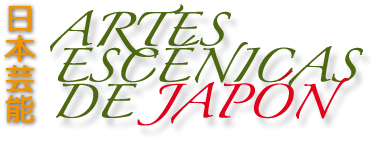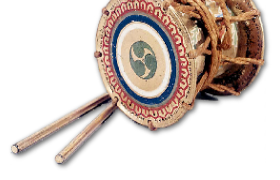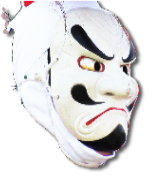





En Progreso








BIBLIOGRAFÍA
-Kishibe Shigeo, Chapter on music in K.B.S. Bibliography of Standard Reference Books for Japanese Studies with Descriptive Notes, Vol. VI (B), Kokusai Bunka Shinkokai, Tokyo, 1960. p. 121-172.
-Kishibe, Shigeo, Ethnomusicology in Japan, Asian Culture Quarterly, Vol. VII, No. 2, Summer 1979, Taipei. p. 28-37.
-Kunst, Jaap, Ethnomusicology, The Hague, Martinus Nijhoff, 1959. (3rd edition). 303 p.
-Mitani, Yoko and Kishibe, Shigeo, An Annotated Catalogue of Major Record Albums and Music Books in Staff Notation of the Traditional Music of Japan, Music and the World, Magazine of the Japanese National Committee of International Music Council, No. 2, 1976. p. 17-36.
-Waterman, R.A., Lichtenwanger, W., Herrmann, V.H., Poleman, H.I. and Hobbs, C., Bibliography of Asiatic Music, V. Central East Asia, B, Japan, NOTES, Music Library Association, Second Series, Vol. VII, No. 2, March, 1950. P. 265-279
General y de Historia
-Eckardt, Hans, Japanische Musik, in Musik in Geschichte und Gegenwart, Kassel and Basel, Baerenreiter, 1960. 1722-1752 p.
-Harich-Schneider Eta, A History of Japanese Music, London, Oxford University Press, 1973. 720 p. 3 45 cm 33 1/3 R.P.M.
-Hogaku hyakka jiten. Kikkawa Eishi, ed. Tokyo: Ongaku no Tomosha, 1984. (Enciclopedia de Música Tradicional Japonesa)
-Iba Takashi. Nihon ongaku gairon. Tokyo: Koseikaku Shoten, 1928. (Introducción a la Música Japonesa)
-K.H.S. Bibliography of Standard Reference Books for Japanese Studies. Tokyo: Kokusai Bunka Shinkokai, 1960.
-Kikkawa Eishi. Nihon ongaku no bitekikenkyu. Tokyo: Ongaku no Tomosha, 1984. (Estudios sobre la Estética de la Música Japonesa).
-Kikkawa Eishi. Nihon ongaku no rekishi. Osaka: Sogensha, 1965. (Historia de la Música Japonesa).
-Kishibe Shigeo and others, Japan, The New Grove Dictionary of Music and Musicians, Vol. g, London, Macmillan, 1980. p. 504-552.
-Kishibe Shigeo. The Traditional Music of Japan. Tokyo: The Japan Foundation, 1984.
-Koizumi Fumio. Nihon no oto: sekai no naka no Nihon ongaku. Tokyo: Seidosha, 1977. (Sonidos del Japón: la Música Japonesa en el Contexto Mundial).
-Koji ruien, Vols. 43, 44 (marcados como Parte I y II). Goto Ryoichu, ed. Kyoto: Koji Ruien Kankokai, 1931. (Selección de Textos Antiguos).
-Konakamura Kiyonori. Kabu ongaku ryakushi. Tokyo: Yoshikawa Hanshichi, 1888. 2 vols. Reprint Iwanami Shoten, 1964. (Breve Historia de la Música para Cantos y Danzas).
-Landy Pierre, Musique du Japon, Les Traditions Musicale, V. Buchet/ Chastel, 1970. 327 p.
-Malm, William P., Japanese Music and Musical Instruments, Rutland Vermont and Tokyo, Charles E. Tuttle, 1959. 299 p.
-Malm, William. "Practical Approaches to Japanese Music" in The Garland Library of Readings in ethnomusicology, Vol. 2. Kay Kaufman Shelemay, ed. New York: Garland, 1990.
-Mueller, Friedrich W.K., Einige Notizen ueber die Japanishce Musik, Mitteilungen der Deutschen Gesellschaft fuer Natur-und Voelkerkunde Ostasiens, I, fasc. 6, 1876.
-Musical Notation of Japan. Steven G. Nelson, ed. Tokyo: Ueno Gakuen University, 1983.
-Nihon no ongaku (rekishi to riron). Tokyo: Kokuritsu Engeki Geino Kanshoza, 1974. (Música Japonesa -Historia y Teoría).
-Nihon ongaku daijiten. Hirano Kenji, ed. Tokyo: Heibonsha, 1989. (Enciclopedia de Música Japonesa).
-Nihon ongakushi kenkyu. Fukushima Kazuo, ed. Tokyo: Research Archive for Japanese Music, 1996- . "Estudios en Historia de la Música Japonesa."
-Piggott, Francis T., The Music and Musical Instruments of Japan, London, 1909. 196 p.
-Sources of Early Japanese Music. Hirano Kenji y Fukushima Kazuo, eds. Tokyo: Benseisha, 1978.
-Studien zur traditionelle Musik Japans. Robert Gunther, ed. Basel: Barenreiter, 1979- . (Henceforth STMJ.)
-Takano Tatsuyuki. Nihon Kayoshi. Tokyo: Shunjusha, 1926. Reprint 1938. (Historia de la Música Vocal del Japón).
-Tanabe Hisao. Hogakuka no tame no ongaku riron. Tokyo: Hogakusha, 1977. (Teoría Musical para Musicos Japoneses).
-Tanabe Hisao. Hogaku yogo jiten. Tokyo: Tokyodo Shuppan, 1975. (Diccionario de Terminología Musical Japonesa).
-Tanabe Hisao. Nihon gakki jiten. Tokyo: Soshisha Shuppan, 1964. (Instrumentos Musicales del Japón).
-Tanabe Hisao. Nihon no ongaku. Tokyo: Bunka Kenkyusha, 1954. (Música Japonesa).
-Toyo ongaku sensho. Tokyo: Toyo Ongaku Gakkai. 1950- . (Selección de Escritos sobre la Música del Lejano Oriente).
-Tsuge Genichi. Japanese Music: An Annotated Bibliography. New York: Garland, 1986.
Gagaku
-Eckardt Hans, Das Kokonchomonshu des Tachibana Narisue als musikgeschichtliche Quelle, Weisbaden, Otto Harassowits, 1956. 432 p.
-Garfias Robert, Music of a Thousand Autumns, The Togaku Style of Japanese Court Music, Berkley, Los Angeles and London, University of California Press, 1975. 322 p.
-Gosenfu ni yoru gagaku sofu. Shiba Sukehiro, ed. Tokyo: Kawaigakufu, 1968-72. 4 vols.
-Harich-Schneider Eta, The Rhythmical Patterns in Gagaku and Bugaku, Leiden, E. J. Brill, 1954. 109 p.
-Harich-Schneider Eta, Roei, The Medieaval Songs of Japan, Tokyo, Sophia University Press, 1965. 132 p.
-Hayashi Kenzo. Gagaku. TOS, Vol. 10.
-Markham, Elizabeth. Saibara. Cambridge: Cambridge University Press, 1983. 2 vols.
-Murasaki Shikibu. The Tale of Genji, trans. by Edward G. Seidensticker. New York: Knopf, 1978.
-Musica Asiatica. Laurence Picken, ed. Oxford: Oxford University Press, 1977-.-Nelson, Steven G. "Gagaku: Its Past and Present" in Gagaku no dezain. Ono Tadamaro, ed. Tokyo: Shogakukan, 1990.
-Ogi Mitsuo. Nihon kodai ongaku shiron. Tokyo: Yoshikawa Kobunkan, 1978. "Teoría de la Música Antigua del Japón."
-“Shosoin no gakki” y “Shosoin no men”. Tokyo: Nihon Keizai Shimbunsha, 1967. "Instrumentos Musicales del Tesoro Shosoin" y "Mascaras del Shosoin."
-Togi Masataro, Gagaku, Court Music and Dance, Performing Arts of Japan; V, New York and Tokyo, Walker/Weatherhill, 1971. 207 p.
-Wolz Carl, Bugaku, Japanese Court Dance, Providence, Asian Music Publications, 1971. 181 p.
-Yamada Yoshio. Genji monogatari no ongaku. Tokyo: Hobunkan, 1969. "La Música en La Historia de los Genji."
Shômyô
-Giesen Walter, Zur Geschichte des buddhistischen Ritualgesangs in Japan, Studien zur traditionellen Musik Japans, Band I, Kassel-Basel, Tours and London, Baerenreiter, 1977. 355 p.
Biwa
-De Ferranti, Hugh. "Composition and Improvisation in Satsuma Biwa" en Musica Asiatica, Vol 6. Cambridge: Cambridge University Press, 1991, 102-27.
-Guignard, Silvain. "Structure and Performance of a Melodic Pattern, Haru Nagashi, in Chikuzenbiwa" en The Oral and the Literate in Music. Tokumaru Yoshiko y Yamaguchi Osamu, eds. Tokyo: Academia Music, 1986, 273-87.
-Heikebiwa katari to ongaku. Kamisango Yuko, ed. Tokyo: Hitsuji Shobo, 1993. "Narración y Música de Heikebiwa."
-Kimura Riro. Higo biwahiki Yamashika Yoshiyuki yobanashi. Tokyo: Sanichi Shobo, 1994. "La Autobiografía de Yamashika Yoshiyuki, intérprete ciego de Biwa."
-Kishibe Shigeo. "The Origin of the P'ip'a" en The Transactions of the Asiatic Society of Japan, second series, Vol. 19 (December 1940), 261-304 and plates.
-McCullough, Helen. Tale of the Heike. Stanford: Stanford University Press, 1988.
-Ruch, Rarbara. "Medieval Jongleurs and the Making of a National Literature" en Japan in the Muromachi Age. John Hall y Toyoda Takeshi, eds. Berkeley: University of California Press, 1977.
-Schmitz, Heinz-Eberhard. Satsumabiwa. STMJ, Vol. 7, 1994.
-Tateyama Zennoshin. Heike onguku shi. Tokyo: Kimura Anju, 1910. Reprint 1978. "Historia de la Música del Heike."
-Otsubo Sojiro. Chikuzenbiwa monogatari. Tokyo: Asahishinbunsha, 1929. Reprint 1983. "El Relato de Chikuzenbiwa."
Noh
-Bethe, Monica, and Brazell, Karen. Dance in the No Theater, Vol. 29. Cornell East Asia Papers. Ithaca: Cornell University China-Japan Program, 1982.
-Bethe, Monica, and Emmert, Richard. Noh Performance Guide, Vol. I. Tokyo: National Noh Theater, 1992.
-Emmert, Richard. "Hiranori" in Musical Voices of Asia. Tokyo: The Japan Foundation, 1980.
-______________ "The Maigoto of No- a Musical Analysis of the Chu no Mai" in Yearbook for Traditional Music, Vol. 15, 1983.
-Komparu Kunio. The Noh Theater. Tokyo: Weatherhill, 1983.
-Matsuyama Yoshio, Studien zur No-Musik, Beitraege zur Ethnomusikologie 8, Hamburg, Karl Dieter Wagner, 1980. 407 p.
-Miyake Koichi. Fushi no seikai. Tokyo: Hinoki Shoten, 1955.
- ____________ Jibyoshi seikai. Tokyo: Hinoki Shoten, 1954.
- ____________ Shidai kara kiri made no utaikata. Tokyo: Hinoki Shoten, 1952.
-Morita Misao. Yokyoku mai hyoshi taisei. Osaka: Yoshida Yokyoku Shoten, 1914
-Nakamura Yasuo, Noh, The Classical Theater, Performing Arts of Japan: IV, New York and Tokyo, Walker/Weatherhill, 1971. 248 p.
-Tamba Akira, La Structure Musical du No, Paris, Klincksieck, 1974. 245 p. 2 45 cm 33 1/3 R.P.M.
-The Noh Drama: Ten Plays, Selected and Translated from the Japanese, Vol. 1. Tokyo: Charles E. Tuttle, 1955. Vols. 2 y 3 se titulan “Japanese Noh Drama”. Tokyo: Nippon Gakujutsu Shinkokai, 1959, 1960.
-Yokyoku hyakuban. Nishino Haruo, ed. Tokyo: Iwanami Shoten, 1998.
Koto
-Ackermann, Peter. Studien zur koto-musik von Edo. STMT, Vol. 6, 1986.
-Adriaansz Willem, The Kumiuta and Danmono, Traditions of Japanese Koto Music, Berkley, Los Angeles and London, University of California Press, 1973. 493 p.
-Gunther, Robert, y Mabuchi Usaburo. Quellen zur Kammermusik der Edo-Zeit. STMJ, Vol. 3, 1985.
-Ikutaryu sokyoku zenshu. Tokyo: Hogakusha, 1983-84. 4 vols.
-Kikkawa Eishi. The History of Japanese Koto Music and Ziua, con dos CDs. Tranducción con suplementos de Leonard C. Holvik, ed. de Yamaguti Osamu. Tokyo: Mita Press, 1997.
-Matsuda Toshu. Sokyoku kashi kaimei. Tokyo: Hogakusha, 1983. "An Elucidation of the History of Koto Vocal Chamber Music."
-Sokyoku to jiuta. TOS, Vol. 3, 1967. "Música Koto y Jiuta."
-Tsuge Genichi. Anthology of Sokyoku and Jiuta Song Texts. Tokyo: Academia Music, 1983.
-Wade Bonnie, Tegotomono, Music for the Japanese Koto, Westport, Conn. and London, Greenwood Press, 1976. 379 p.
-Yamadaryu sokyoku gakufu. Tokyo: Hogakusha, 1957-. "Notación de Koto del Estilo Yamada."
-Yamazaki Shinko. Yatsuhashiryu koto kumiuta no kenkyu. Kikkawa Eishi, ed. Tokyo: Zenongakufu Shuppansha, 1988. "Un Estudio sobre Kumiuta en la Escuela Yatsuhashi de Koto."
-Yoshida Bungo. Nihon no koto. Hiroshima: Keisuisha, 1984. "El Koto Japonés."
Shamisén
-Adriaansz Willem, Introduction to Shamisen Kumiuta, Buren, The Netherlands, Frits Knuf B. V., 1978. 127 p.
-Atsumi Seitaro. Hogaku buyo. Tokyo: Fuzambo, 1956. "Dictionary de Música para Danza Japonesa."
-Crihfield, Liza. Ko-uta:"Little Songs" of the Geisha World. Tokyo: Charles E. Tuttle, 1979.
-Gerstle, C. A., Inobe, K., y Malm, W. Theater as Music. Ann Arbor: Center for Japanese Studies, 1990.
-Gerstle, C. A. Circles of Fantasy. Cambridge, MA: Harvard University Press, 1986.
-Keene, Donald. Bunraku. Tokyo: Kodansha International, 1965.
-Malm, William. Nagauta: The Heart of Kabuki Music. Tokyo: Charles E. Tuttle, 1963.
- ____________. "The Rise of Concert Shamisen Music in Nineteenth-Century Japan" en Recovering the Orient: Artists, Scholars, Appropriations. Bob Haddad, ed. Reading, U.K.: Harwood, 1994.
- _____________. Six Hidden Views of Japanese Music. Berkeley: University of California Press, 1986.
-Shamisen to sono ongaku. TOS, Vol. 7, 1978. "El Shamisen y su Música."
-Tokita, Alison. Kiyomoto-bushi: Narrative Music of the Kabuki Theater. STMJ, 2000.
Shakuhachi
-Berger, Donald Paul. "The Shakuhachi and the Kinko Ryu Notation" en Asian Music, 1-2, 1969.
-Blasdel, Christopher. The Shakuhachi: A Manual for Learning. Tokyo: Ongaku no Tomosha, 1988.
-Borris Siegfried, Musikleben in Japan, Kassel, Basel, Paris, London and New York, Baerenreiter, 1967. 246 p.
-Fritsch Ingrid, Die Solo-Honkyoku der Tozan-Schule, Studien zur traditionellen Musik Japans, Band 4, Kassel, Basel, Tours, and London, Baerenreiter, 1979. 241 p. (Modern age)
-Gould, Michael, y Taniguchi Yoshinobu. How to Play Classical Shakuhachi. Willits, CA: Tai Hei Shakuhachi, 1996.
-Gutzwiller, Andreas. Die Shakuhachi der Kinko-Schule. STMJ, Vol. 5, 1983.
-Kozuki Enzan. Shakuhachi seisakuho taizen. Tokyo: Takeda Toshado, 1933. 2 vols. Reprint 1977.
-Machida Kasho and others, Japanese Music and Drama in the Meiji Era, Vol. III of Japanese Culture in the Meiji Era edited by Komiya Toyotaka, Tokyo, Obunsha, 1956. 535 p.
-May Elizabeth, The Influence of the Meiji Period on Japanese Children's Music, Berkley and Los Angeles, University of California Press, 1963. 95 p.
-Shakuhachi Encyclopedia of Musical Instruments. Tanimura Ko, ed. Tokyo: Ongakusha,1990.
-Tanaka Inzan. Gosenfu kara Shakuhachi no torikata. Tokyo: Ongaku no Tomosha,l956.
-Toya Deiko. Komuso shakuhachi shinan. Fukuoka: Komuso Kenkyukai, 1984. "Instrucciones para Komuso Shakuhachi."
-Ueno Katami. Shakuhachi no rekishi. Tokyo: Kyowa Shuppansha, 1983. "Historia del Shakuhachi."
-Weisgarber, Elliot. "The honkyoku of the Kinko-ryu" en Ethnomusicology, Vol. 12, No. 3, 1968.
Instrumentos Musicales
-Kishibe Shigeo, The Origin of the K'ung-hou (Chinese Harp), TOYO ONGAKU KENKYU (Journal of the Society for Research in Asiatic Music), Nos 14/15, December 1958. p. 1-51.
-Kishibe Shigeo, The Origin of the P'i-p'a with Particular Reference to the Five-stringed P'i-p'a Preserved in the Shosoin, The Transactions of the Asiatic Society of Japan, Second Series, Vol. XIX, December 1940 p. 259-304.
Teatro
-Ando Tsuruo, Runraku, The Puppet Theater, Performing Arts of Japan; I, New York and Tokyo, Walker/Weatherhill, 1970. 272 p.
-Crump J.I. and Malm W.P. (ed.), Chinese and Japanese Music-Dramas, Michigan Papers in Chinese Studies, No. 19, Ann Arbor, Center for Chinese Studies, The University of Michigan, 1975. 255 p.
-Inoura Yoshinobu and Kawatake Toshio, The Traditional Theater of Japan, Tokyo, The Japan Foundation, 1981. 259 p.
-Toita Yasuji, Kabuki, The Popular Theater, Performing Arts of Japan; II, New York, Tokyo and Kyoto, Weatherhill/Tankosha, 1970. 247 p.
Kabuki
-Brandon, James. Kabuki: Five Classical Plays. Honolulu: University of Hawaii Press, 1992.
-Brandon, James, Malm, W., y Shively, D. Studies in Kabuki. Honolulu: University of Hawaii Press, 1978.
-Ernst, Earle. The Kabuki Theater. Honolulu: University of Hawaii Press, 1956.
-Gunji Masakatsu. Kabuki. Tokyo: Kodansha International, 1969. Revised 1985.
-Halford, Aubrey. The Kabuki Handbook. Tokyo: Charles E. Tuttle, 1956.
-Kabuki. TOS, Vol. 12, 1980.
-Kabuki Encyclopedia. Samuel Leiter, ed. London: Greenwood Press, 1979.
-Kineya Eizaemon. Kabuki ongaku shusei. Tokyo: Kabuki Ongaku Shusei Kankokai, 1976. "Una Recopilación de Música Kabuki."
-Mochizuki Tainosuke. Kabuki no geza ongaku. Tokyo: Engeki Shuppansha, 1975. "La Música en la Transescena del Kabuki."
Danza
-Gunji Masakatsu, Buyo, The Classical Dance, Performing Arts of Japan; III, New York, Tokyo and Kyoto, Weatherhill/Tankosha, 1970. 207 p.
Música Rural y Popular
-Fujisawa Morihiko. Hayariuta hyakunenshi. Tokyo: Daiichi Shuppansha, 1951. "Cien Años de Música Popular."
-Groemer, Gerald. Bakumatsu no hayariuta. Tokyo: Meicho Shuppan, 1995.
-Hughes, David. " 'Esashi Oiwake' and the Beginnings of Modern Japanese Folk Song" en The World of Music, Vol. 34, 1992.
-Koizumi Fumio. Nihon dento ongaku no kenkyu. Tokyo: Ongaku no Tomosha, 1957. "Un Estudio sobre la Música Tradicional del Japón."
-Kojima Tomiko y Fujii Tomoaki. Nihon no oto no bunka. Tokyo: Daiichi Shobo,1994. "La Cultura del Sonido Japonés."
-Misumi Haruo. Minzoku no geino. Tokyo: Kawade Shobo, 1964. "Artes Escénicas Folclóricas."
-Nihon minyo daijiten. Asano Kenji, ed. Tokyo: Yuzankaku, 1983. "Enciclopedia de Canciones Rurales Japonesas."
-Nihon minyo taikan, Tokyo: Nihon Hoso Shuppan Kyokai, 1953-. "A General Survey of Japanese Folk Songs."
-Nihon no minyo to minzoku. TOS, Vol. 1, 1967. "Canciones Rurales Japonesas y los Grupos Etnicos."
-Nishiyama Matsunosuke. Edo Cultulre: Daily Life and Diversions in Urban Japan, 1600-1868, trad. de Gerald Groemer. Honolulu: University of Hawaii Press, 1997.
-Philippi, Donald. Songs of Gods, Songs of Humans. Tokyo: Tokyo University Press, 1975.
-Soeda Tomomichi. Enka no Meiji Taisho shi. Tokyo: Tosui Shobo, 1982. "Historia de las Canciones Populares en los periodos Meiji y Taisho."
- _______________. Ryukoka Meiji Taisho shi. Tokyo: Tosui Shobo, 1952. "Historia de la Música Popular de los periodos Meiji y Taisho."
